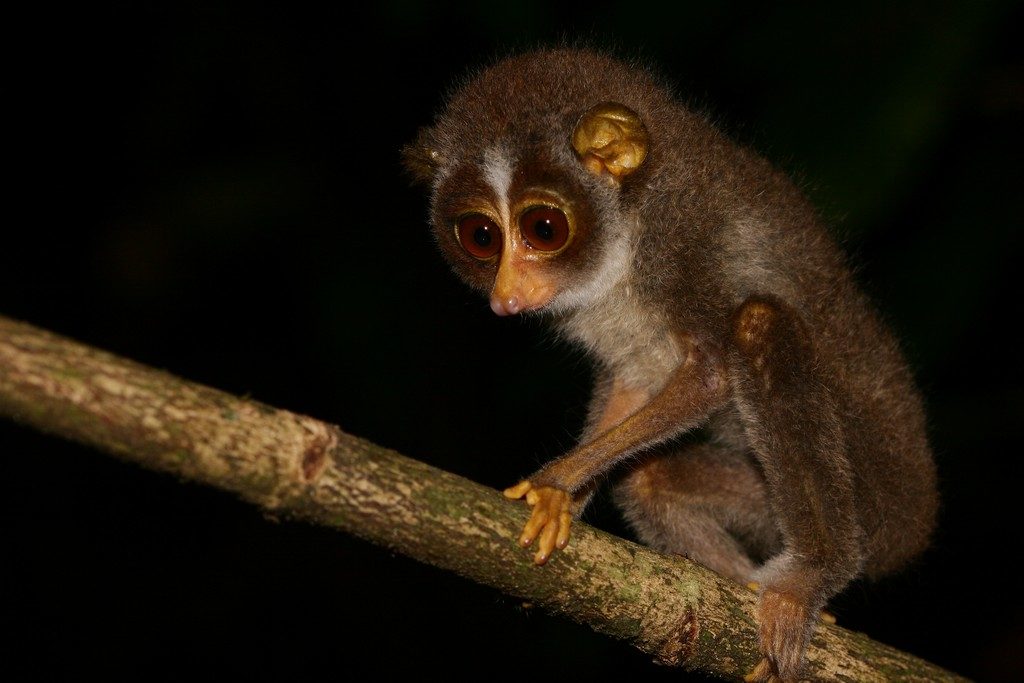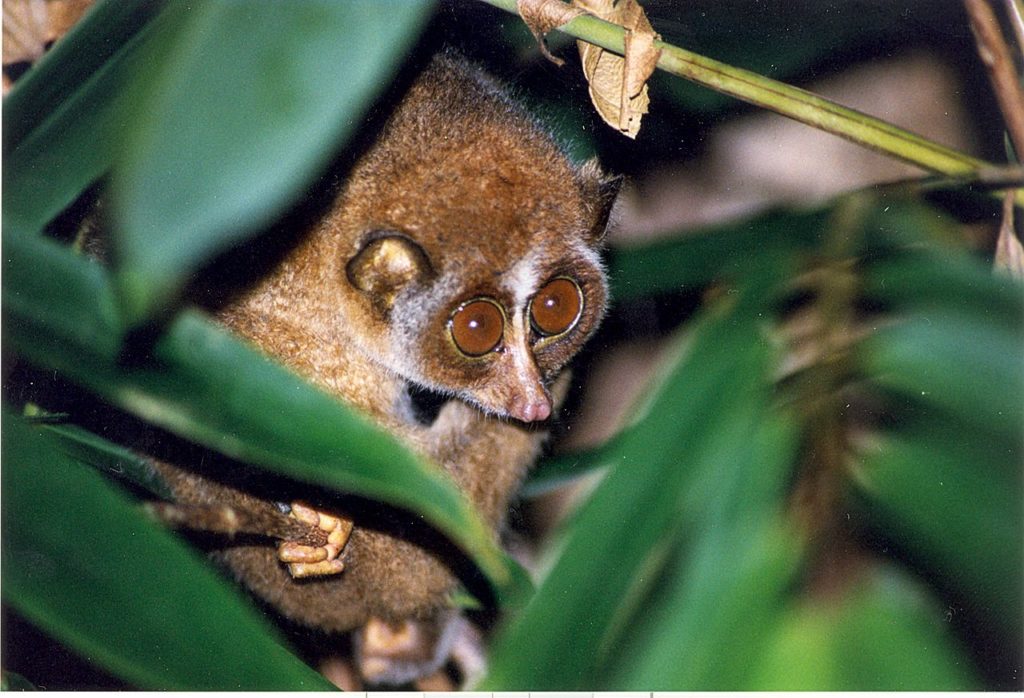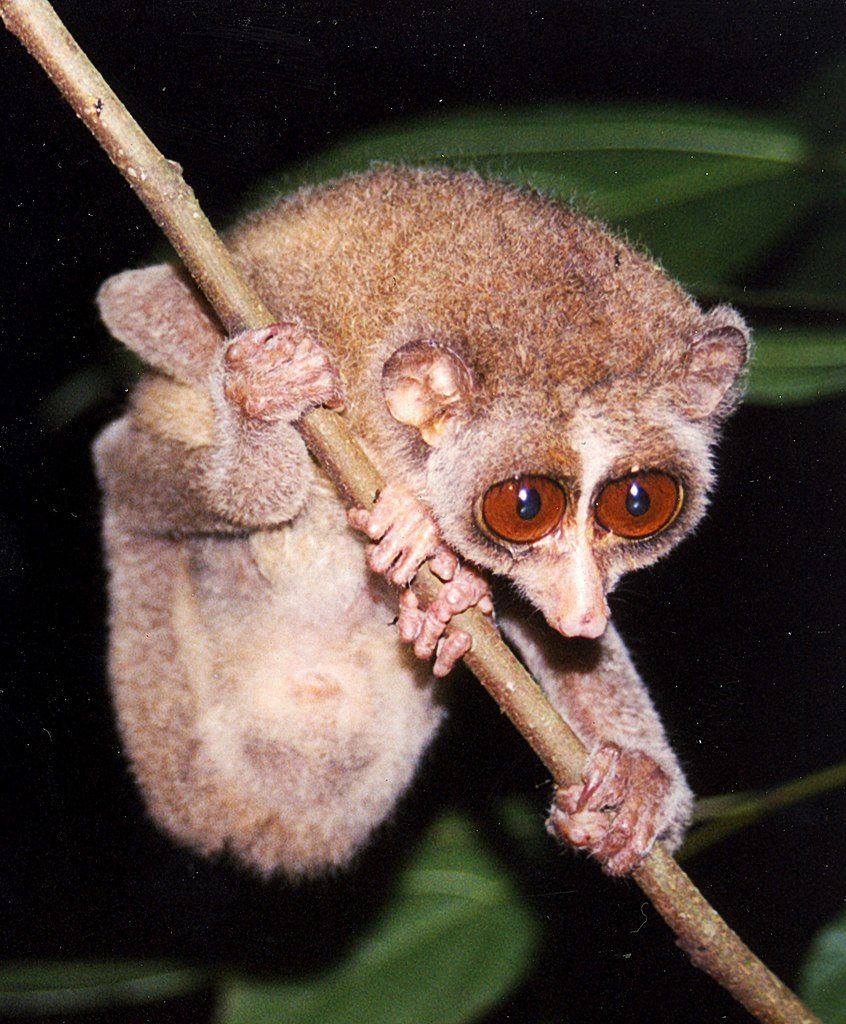Red slender loris facts, pictures, video and information. Discover a rare rainforest primate…
Red Slender Loris Facts At A Glance
- Scientific name: Loris tardigradus
- Type of Animal: Mammal
- Animal Family: Lorisidae
- Where Found: Sri Lanka
- Length: 18 to 25 cm (7 to 10 in)
- Weight: 85 to 370 g (3 to 13 oz.)
- Conservation Status: Endangered
- See more rainforest animals here: Rainforest Animals List with Pictures & Facts
- See more endangered animals here: Endangered Animals List with Pictures & Facts
- Discover amazing animals from all around the world: A to Z Animals
Meet The Red Slender Loris: Introduction
The red slender loris is a small primate found in the rainforests of Sri Lanka. Threatened by habitat loss, it is among the world’s most endangered mammals.
What Does The Red Slender Loris Look Like?
The red slender loris is well-adapted for life in the trees. It has long, thin, highly-agile limbs. Its hands and feet have opposable digits that allow it to grasp onto branches. It doesn't have a tail, and therefore relies on its slender limbs and strong hands and feet while climbing.
The red slender loris's pale face is dominated by its two large, round, forward-facing eyes. The eyes are orange-brown in color, and each is surrounded by a dark patch of fur. (The large eyes are an adaptation for hunting in the trees at night).
The loris's snout is somewhat pointed and ends with a fleshy tip. The ears are round and thin, with little or no hair along the edges. The coat is soft and dense, with slight differences in color between the two subspecies (see below).
Red Slender Loris Subspecies
Currently, two subspecies of red slender loris are recognized: the Dry Zone slender loris Loris tardigradus tardigradus (also known as the western, or lowland red slender loris) , and the Horton Plains red slender loris Loris tardigradus nycticeboides (also known as the montane slender loris) .
Loris tardigradus tardigradus has a reddish-brown coat with creamy yellow undersides.
Loris tardigradus nycticeboides has dark brown upperparts and light brown undersides.
The young of both subspecies are grayish in color.
A third subspecies, the northwestern red slender loris (Loris tardigradus parvus), was suggested in a study published in 2017.
Lorises & Related Animals
The red slender loris is a member of the primate suborder Strepsirrhini, which also contains lemurs and bush babies.
Strepsirrhini is one of the two main primate groups, the other being the suborder Haplorhini, which contains apes (including humans), monkeys and tarsiers.
The red slender loris is a member of the family Lorisidae. It is one of two slender loris species (the other slender loris species is the gray slender loris).
Also in the family Lorisidae are around eight species of slow loris.
Where Is The Red Slender Loris Found?
The red slender loris is endemic to (i.e. only found in) Sri Lanka. Sri Lanka is an island country located in the Indian Ocean off of the southeast tip of India.
You can see Sri Lanka on the map below. Zoom out to see where it is in relation to your own country.
- Loris tardigradus tardigradus occurs throughout the wet parts of the southwestern region of Sri Lanka.
- Loris tardigradus nycticeboides is only found in the highlands towards the center of the country.
Habitat
The red slender loris is arboreal (tree-dwelling) and has several adaptations for this lifestyle. These include: long bones, very strong digits, and joints that are highly mobile.
The red slender loris’s forward-facing eyes give it ‘binocular vision’, enabling it to judge distances better than animals with eyes on the sides of their heads.
Each of the two red slender loris subspecies is found in a different habitat:
- Loris tardigradus tardigradus occurs in wet lowland forests, tropical rainforests, swampy coastal forests and evergreen forests below elevations of 700 m (2,300 ft.).
- Loris tardigradus nycticeboides is found in mist forests at elevations of 1,600 to 2,100 m (5,200 to 6,900 ft.).
Behavior
During the day, red slender lorises form small sleeping groups that typically consist of an adult female, her offspring, and an adult male. The group sleeps during the daylight hours in branch tangles or in tree hollows. When not sleeping, the members of the group engage in grooming, huddling, play-biting and play-wrestling behavior.
During the night, the lorises disperse to forage alone.
Communication
The red slender loris is unusually social for a nocturnal primate. It communicates using a variety of vocalizations, which include loud whistles, chitters, growls, screams and other calls.
Individuals call to each other throughout the night, potential mates vocalize during courtship, and infants and their mothers communicate using specific vocalizations. The lorises also appear to direct calls at potential predators.
Urine marking is also used extensively by the red slender loris. Other types of communication between individuals include facial expressions, body postures and gestures.
Movement
The red slender loris may also be capable of leaping over short distances.
Red Slender Loris Life Cycle
The mating system of the red slender loris may be ‘promiscuous’ (a system in which both sexes mate with multiple partners) or it may involve males competing for females. Male lorises venture further than females, and have home ranges that overlap those of several females.
Females are thought to breed twice a year. The courtship may last for hours, during which both the male and the female loris vocalize extensively. While mating, the pair hangs upside down from a branch.
Gestation lasts between 166 and 175 days, after which the female gives birth to single infant (or occasionally, twins). The infant clings onto the fur of its mother for approximately 4 weeks. Older young stay behind in a sheltered location while the mother goes foraging.
The milk of the red slender loris is very high in fat and protein. The mother nurses her young for 6 to 7 months.
What Does The Red Slender Loris Eat?
The red slender loris primarily consumes insects such as moths, cockroaches, grasshoppers, dragonflies, stick insects and beetles. It will also eat bird eggs and small vertebrates such as frogs and lizards. Every part of a prey animal is consumed, including bones and scales.
Plant matter, including fruit, berries, leaves and buds, also forms part of the loris’s diet.
The red slender loris hunts alone at night. It approaches its prey slowly and quietly before suddenly grasping it with one or both hands.
It is thought that chemicals present in insects consumed by the red slender loris may be used by the animal to mask its own smell; during foraging, the loris frequently rubs urine over itself.
The metabolic rate of the red slender loris is slow for its body size.
Red Slender Loris Predators
Little is known about red slender loris mortality rates from predation. It is likely that the small animal falls victim to a number of predators, including viverrids (genets and civets), felids (cats) and raptors (birds of prey).
The red slender loris has brachial glands on the inside of its arms which produce volatile chemicals which may have a predator-deterring function.
Is The Red Slender Loris Endangered?
The red slender loris is rated ‘Endangered’ by the IUCN.
The greatest threat to both subspecies is habitat loss. Other threats include their use in traditional medicine, collection for the pet trade, and collisions with vehicles on roads.




